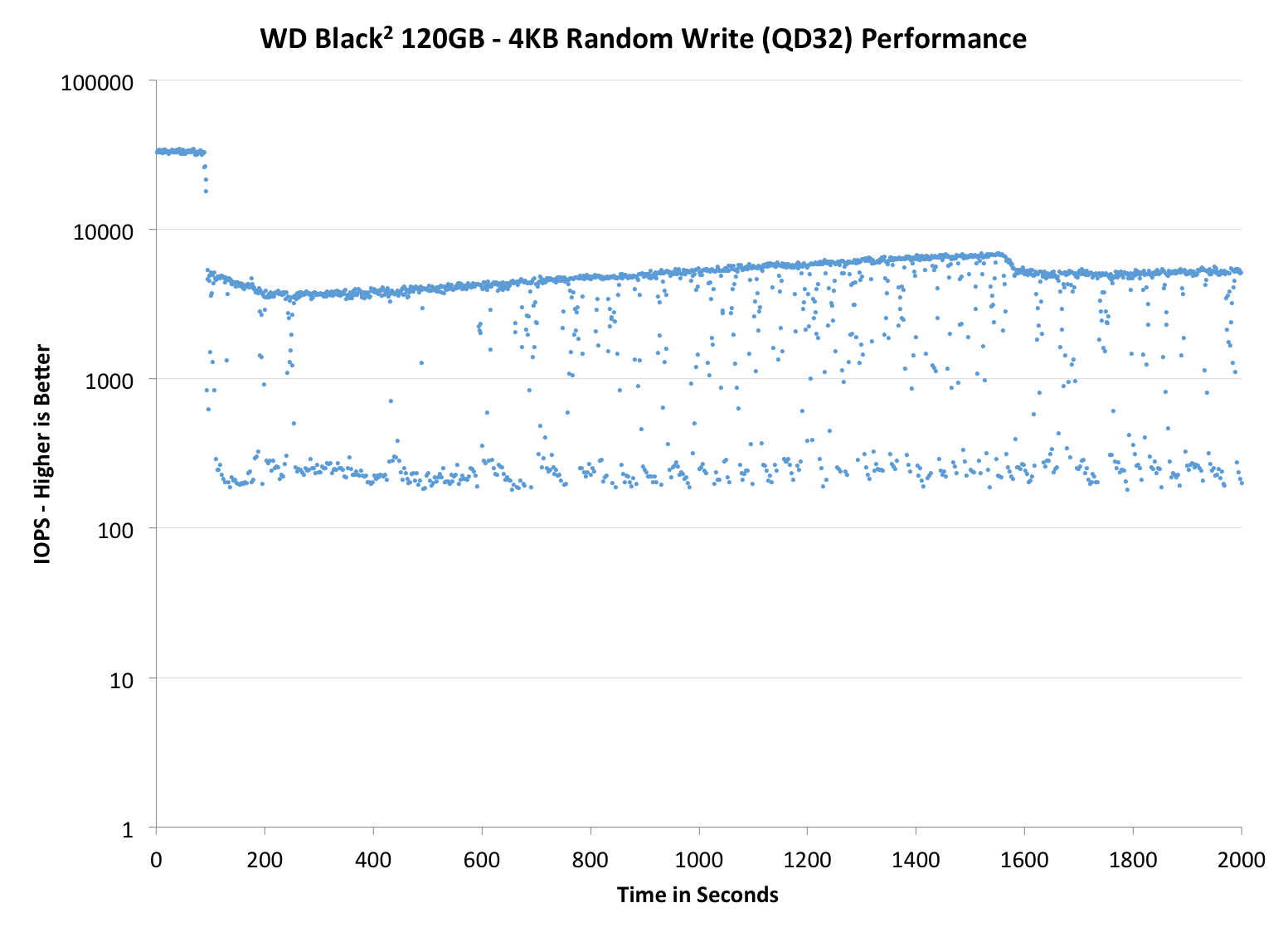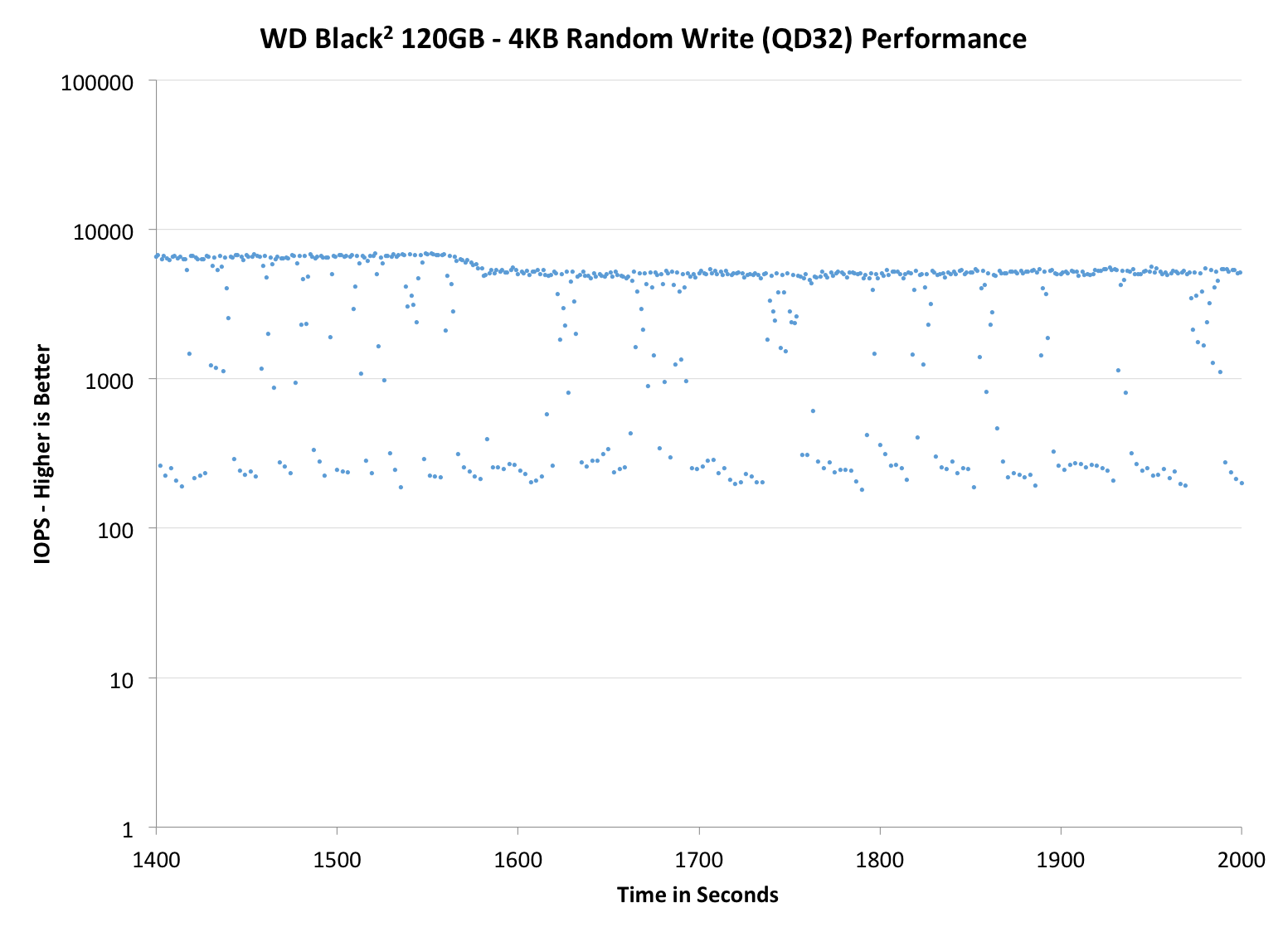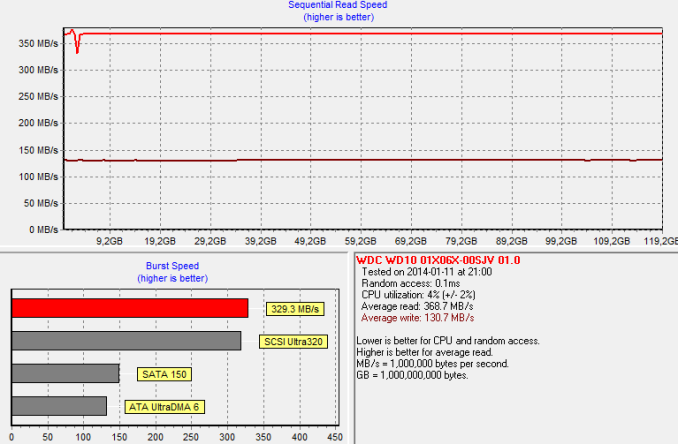The WD Black2 Review: World's First 2.5" Dual-Drive
by Kristian Vättö on January 30, 2014 7:00 AM ESTPerformance Consistency
Performance consistency tells us a lot about the architecture of these SSDs and how they handle internal defragmentation. The reason we don’t have consistent IO latency with SSD is because inevitably all controllers have to do some amount of defragmentation or garbage collection in order to continue operating at high speeds. When and how an SSD decides to run its defrag or cleanup routines directly impacts the user experience as inconsistent performance results in application slowdowns.
To test IO consistency, we fill a secure erased SSD with sequential data to ensure that all user accessible LBAs have data associated with them. Next we kick off a 4KB random write workload across all LBAs at a queue depth of 32 using incompressible data. The test is run for just over half an hour and we record instantaneous IOPS every second.
We are also testing drives with added over-provisioning by limiting the LBA range. This gives us a look into the drive’s behavior with varying levels of empty space, which is frankly a more realistic approach for client workloads.
Each of the three graphs has its own purpose. The first one is of the whole duration of the test in log scale. The second and third one zoom into the beginning of steady-state operation (t=1400s) but on different scales: the second one uses log scale for easy comparison whereas the third one uses linear scale for better visualization of differences between drives. Click the buttons below each graph to switch the source data.
For more detailed description of the test and why performance consistency matters, read our original Intel SSD DC S3700 article.
 |
|||||||||
| WD Black2 120GB | Samsung SSD 840 EVO mSATA 1TB | Mushkin Atlas 240GB | Intel SSD 525 | Plextor M5M | |||||
| Default | |||||||||
| 25% OP | - | ||||||||
The area where low cost designs usually fall behind is performance consistency and the JMF667H in the Black2 is no exception. I was actually expecting far worse results, although the JMF667H is certainly one of the worst SATA 6Gbps controllers we've tested lately. The biggest issue is the inability to sustain performance because while the thickest line is at ~5,000 IOPS, the performance is constantly dropping below 1,000 IOPS and even to zero on occasion. Increasing the over-provisioning helps a bit, although no amount of over-provisioning can fix a design issue this deep.
 |
|||||||||
| WD Black2 120GB | Samsung SSD 840 EVO mSATA 1TB | Mushkin Atlas 240GB | Intel SSD 525 | Plextor M5M | |||||
| Default | |||||||||
| 25% OP | - | ||||||||
 |
|||||||||
| WD Black2 120GB | Samsung SSD 840 EVO mSATA 1TB | Mushkin Atlas 480GB | Intel SSD 525 | Plextor M5M | |||||
| Default | |||||||||
| 25% OP | - | ||||||||
TRIM Validation
To test TRIM, I first filled all user-accessible LBAs with sequential data and continued with torturing the drive with 4KB random writes (100% LBA, QD=32) for 30 minutes. After the torture I TRIM'ed the drive (quick format in Windows 7/8) and ran HD Tach to make sure TRIM is functional.
Based on our sequential Iometer write test, the write performance should be around 150MB/s after secure erase. It seems that TRIM doesn't work perfectly but performance would likely further recover after some idle time.











100 Comments
View All Comments
Shadowmaster625 - Thursday, January 30, 2014 - link
What a joke. For $300 you can just buy a 512GB SSD and not have to deal with a 2nd partition that might just decide to disappear at any moment due to its odd driver dependency. There's actually one on sale right now for $260. What is WD smoking?LauRoman - Thursday, January 30, 2014 - link
As i understand it it is not a weird driver dependency. The driver is really only needed to flip a switch that woun't suddenly flip back by itself, even if you destroy the drive's mbr/gpt. It should work in any os after the switch is flipped. I don't know if you need a Windows install to switch it on though.Panzerknacker - Thursday, January 30, 2014 - link
Exactly, that's what I'm thinking as well, the driver is only used to flip a certain switch that's unique in this particular drive. Now that I'm thinking of it they probably did this to help with installing Windows. When installing Windows the installer will only find the 120gb partition, Windows has the strange behaviour of messing around with partitions during installation and putting system stuff on other partitions. Normally you can disconnect the other drives in the system, not on this one ofc because it's 2 in 1. Then when everything is installed you can enable the other partition with the switch triggered by the driver.I'd wonder how you would do this without Windows tho, they should also include a hardware switch.
mikato - Friday, January 31, 2014 - link
I HATE that. Detaching everything but the SSD is standard procedure during Windows installation now because of that. It's a nasty surprise when you decided to take out your hard drive or switch it with another only to find that Windows won't boot now, even when you had installed Windows on the SSD! Do you know if Windows 8 does this?HisDivineOrder - Thursday, January 30, 2014 - link
It's been a long time since WD truly impressed me with a new product.Guspaz - Thursday, January 30, 2014 - link
I've seen the 1TB Samsung 840 EVO go under $500. If you gave me the choice between paying $300 for a slow 1TB HDD with a pretty terrible 120GB SSD, or paying $500 for a fast 1TB SSD, which do you think I'd pick?About the only thing that could make the WD solution interesting is if it offered a substantially more attractive price than the SSD (and "somewhat cheaper" isn't), and if it had the SSD caching solution in hardware so that it could just be plugged in and used as a normal drive.
With a full 1TB SSD costing not much more than this thing, it's not useful for the "notebook with only one 2.5" slot" scenario... or any other scenario.
coolhund - Sunday, February 9, 2014 - link
Exactly. Also keep in mind that SSD prices keep falling and falling, while HDDs still havent gotten back to the prices that we had before that 'flood' and are not really getting cheaper nowadays. And thats why it will fail, just like the hybrid ones. I think it will actually fail even more.mobutu - Thursday, January 30, 2014 - link
Too little, Too lateI mean with very good 1TB SSDs ready to go mainstream at 400-500USD this wd2 is completely useless, especially for all the people that already use SSDs and know what a tremendous impact it has over a hdd dinosaur (performance/power/heat/silence/formfactor) (msata at 1TB already gimme a break must be a joke to look at wd2).
HDDs are close to extinct, it is a matter of time/price until they'll dissapear completely exactly like the FDD ... both are/were huge bottleneck to a system.
chizow - Thursday, January 30, 2014 - link
I thought this was pretty useless when it was announced a few months ago, but with the increasing popularity of SFF and NUC-like devices, this drive would be perfect.Gigaplex - Thursday, January 30, 2014 - link
Or you could just get a 1TB SSD, this drive isn't that much cheaper.